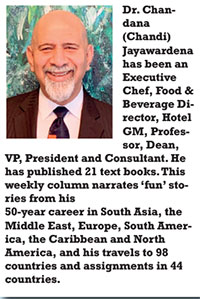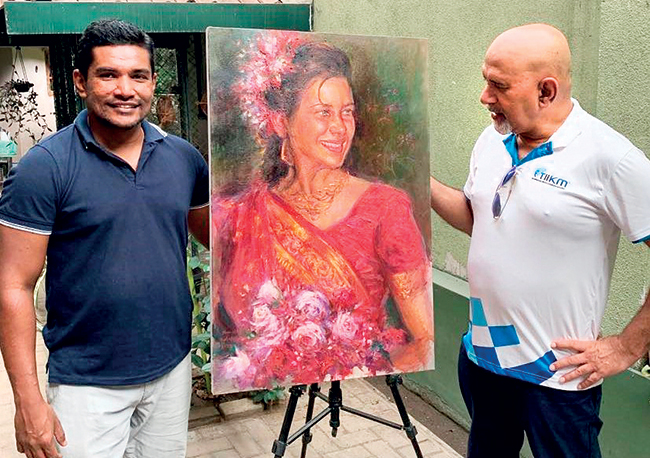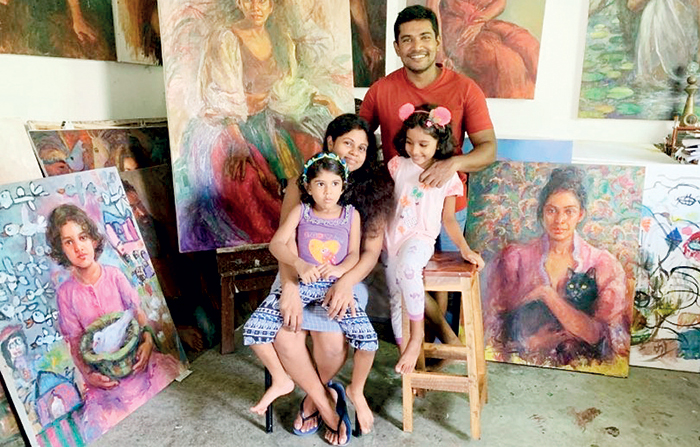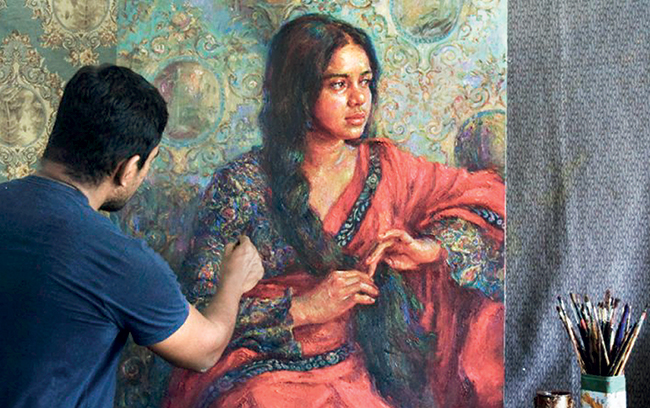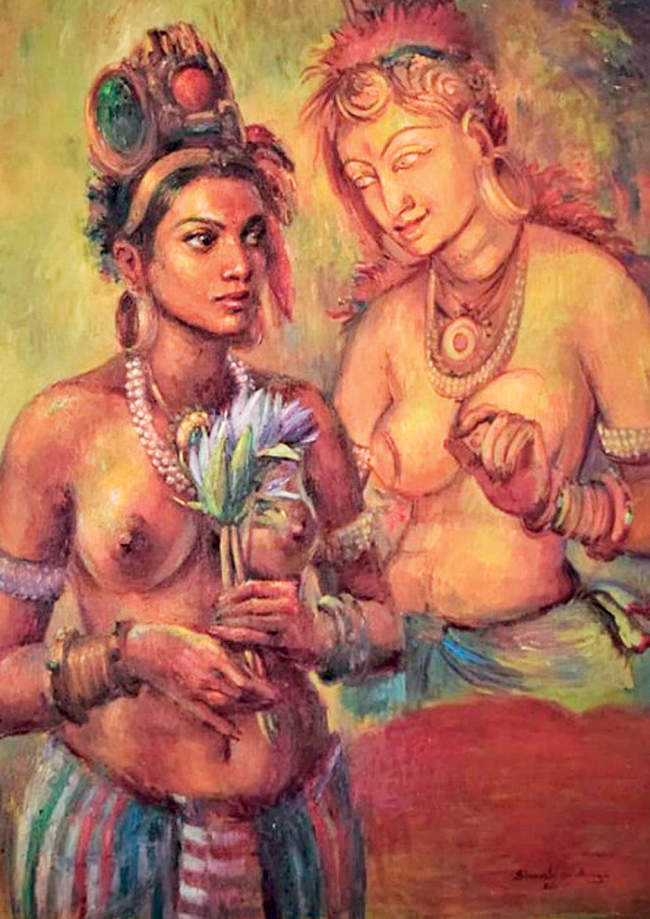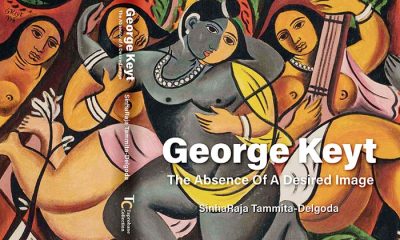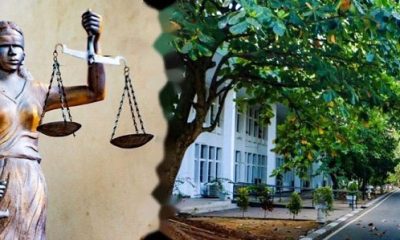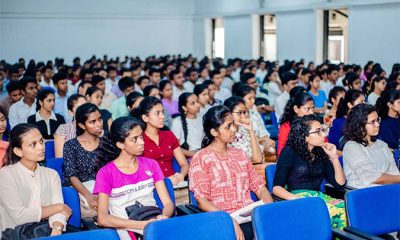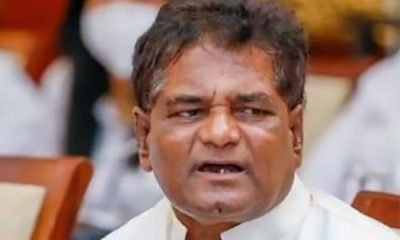Features
Dr. Shanaka Kulathunga A Doctor in the day, an Artist in the evening

PLACES, PEOPLE & PASSIONS (3Ps)
Part nine
Dr. Chandana () Jayawardena DPhil
President – Chandi J. Associates Inc. Consulting, Canada
chandij@sympatico.ca
Profile
Shanaka is a graduate of the Medical Faculty, the University of Colombo. He studied visual art at the Vibhavi Academy of Fine Arts and is now completing an MFA degree at the University of Kelaniya. He has won many awards, and most recently won the first place in the portrait art category in the State Art festival. He has done two solo exhibitions at the Lionel Wendt Art Gallery and has displayed his works in numerous group exhibitions. He has also participated in a few international artist workshops and exhibitions. Shanaka’s favourite area in visual art is human figure and portraiture.
First Meeting in 2003
I first met Shanka, at my elder sister’s house in Borella, when I was on holiday in Sri Lanka with my wife and kids in 2003. “Chandana Mama, meet Shanaka, one of my batch mates at the Medical College. Mama, like seeya and you, Shanaka is an artist,” my nephew Suran introduced another shy youngster to me. Soon I became pleasantly surprised that most of Suran’s friends studying to be doctors had artistic talents. Suran was studying both classical and western music, Shanka was studying visual art, another was an excellent photographer and a few others were musicians performing in bands.
“Thaththa, during my time at Ananada College, the best students who made it to the medical college hardly had any artistic talents or time to pursue hobbies. They all were studious and fully focused on their respected careers in Medicine. How come Suran’s batch mates find time to be engaged in artistic hobbies?” I asked my father, who had intelligent answers to any question. “Chandana, this is a new generation of future doctors. They seem to be far more versatile and better in multi-tasking than most of their predecessors” was his answer.
After a few years, we eventually manipulated Suran to admit that he has a girlfriend. He reluctantly introduced to us a beautiful medical college student a few years junior to him, Varuni. We were surprised that she was a part-time singer, model, and actress. Today, Suran and Varuni, while working as doctors and doing their postgraduate medical studies in the United Kingdom, and raising their seven-year-old son, find time to sing in London during the weekends. Their friend Shanaka works hard in Sri Lanka as a doctor in the day, and as an artist in the evening.
Open for Tips
During my annual trips to Sri Lanka over the next six years, I regularly met Shanaka at my sister’s house. I identified his as a budding landscape artist. He was humble and unassuming. He was also hungry for advice and tips, which my father generously provided to him. Every year I witnessed Shanka blossoming from a shy amateur landscape artist to a confident master visual artist. During his internship from 2010 to 2012, Shanka was very busy and I did not see him too often.
During Suran and Varuni’s wedding in 2013, I met Shanaka again. “I now do life drawings and portraits with pencils and charcoal. May I do one of you?” he offered. Soon he became an excellent portrait artist. Every time I saw Shanaka’s early commissioned work at Varuni’s parents’ house and my younger sisters house I continued to be amazed with his attention to details and patience to accommodate client demands. One day he surprised my father by presenting him with a beautiful 96th birthday present – a portrait of my father. That was Shanka’s way of saying, “Thank you for the tips and support, Uncle!”
Experimenting and Winning Big
During his busy career as a doctor, Shanaka never let his hectic schedule deprive him of using opportunities to explore and experiment in visual art in Sri Lanka and overseas. He was a part of an Artist Exchange Program / Exhibition where he visited Ningxia, China. During this sponsored trip to China, he gained valuable experience in appreciating an ancient civilization and a rich history of visual art and improving his work.
Finally, handsome dividends were paid to Shanaka for his commitment, passion, and hard work when he won first place in the portrait art category in the State Art festival in 2021.
Arriving at Shanaka’s studio in Piliyandala with my elder sister and brother-in-law, Janaki and Premalal Kuruppu, just before the traditional new year in 2023, was a rewarding experience for me. We were warmly welcomed by Shanaka who directed us to climb open air iron steps towards a second-floor room. This top floor adjoining his house is his rustic studio nearly full of masterpieces of his work.
His two daughters, already active visual artists at age seven and five, are regular visitors at the studio. Shanka and his wife, Chathu, have no rules prohibiting their offspring to paint on the walls of their sitting room and dining room. All walls are covered with free style art work done by their daughters. Such freedom for creative expression is, indeed, refreshing, and inspiring!
A Commission close to my Heart
I commissioned Shanaka only once. A few months after my wife Mélaine passed away in 2021 at age 54, I wanted a portrait of my wife, using her homecoming wedding photo taken at Mount Lavinia Hotel. As that image is very close to my heart, unknowingly I became a very difficult customer to Shanaka. I rejected a few early versions of the portrait when Shanaka sent me photographs of work in progress.
“Come on Doctor, you need to get the correct colours as per the reference photograph! My wife’s hair was nearly black and her eyes were blue” I insisted on changes to his work. When he said to me, “I will do my best, Doctor, to make you happy. This is the first time I am doing a portrait of a foreigner, from a photograph. All others have sat in front of me for around six hours.” I understood his challenge.
After several back-and-forth communications, Shanaka eventually produced a beautiful masterpiece. I look at it every morning while having my morning coffee and thinking of my memorable 23 years with Mélaine.
Questions and Answers
Q: Out of all the places you have visited in Sri Lanka and overseas, what is your favourite and most interesting place?
A: National Art Gallery: I was about 10 years old when I first visited there. And I think it was the most influential and inspirational place to me as a 10-year-old child and up to date. That is the only place where you can see a large collection of realistic works by old masters and I was sad that it was closed for several years. I also like Sigiriya mainly because of those timeless frescos.
Q: Out of all the inspiring people you have met, who inspired you most to pursue visual art?
A: I have studied visual art under several teachers. My first teacher was Mr. Lionel Ranaweera. But my biggest inspiration was Prof. Chandraguptha Thenuwara who taught me the discipline of figurative art. That is an experience which is hard to find in a country like Sri Lanka. I was lucky enough to study under him.
Q: At the present time, what is your key passion in life?
A: Fine Art will be my passion forever. It gave me the confidence and strength for my other studies and to the pathway of becoming a doctor. But later, I realized that I was born to be an Artist. Now it has become an addiction.
Q: For how long did you study at the Vibhavi Academy of Fine Arts?
A: I Joined VAFA in 2001 and studied there until 2013 from time to time. It was interrupted by the years I spent in the medical school (2003-2009) and during my internship (2010-2012).
Q: How did you fair at the Speculo Art competition organised by the Sri Lankan Airlines?
A: I did well. I am looking forward such events in the future to exploring new dimensions as an artist and to get rid of local Art Mafia in this country. I am trying to be a true artist which may be not that practical in the fake art field today.
Q: Why did you theme your last solo exhibition: ‘Soul Windows’?
A: Most of the times I use sitters, live models for my paintings. While painting I try to capture their emotions and personality. Eyes are very important in expressing emotions in a person and in painting a portrait. Therefore, by the meaning of “Eyes are the windows to the soul” I named it ‘Soul Windows’.
Q: Have you introduced any new concepts in visual art?
A: Yes. I now do live wedding paintings in weddings. This is a new concept in Sri Lanka although can be seen in other countries. I use oils which a challenging but an interesting medium. I go to the venue of the wedding a little before the event and start painting the background and decorations. It might vary. And according to the clients desire I will paint either poruwa, first dance, or just the couple or a scene from the occasion.
Q: What was the most challenging commissioned work you have handled?
A: Recently I did the portrait of the Mr. P. J. Harpol the Thai ambassador as a live painting. He was very helpful by spending time to pose and complete the painting and it was one of the very successful portraits done by me. I am glad that I was able to paint a good art lover like him. His traditional outfit he had chosen for this painting was very inspiring.
Q: What does your schedule of a normal working day, look like?
A: After finishing my hospital work I try to come home where my studio is located and my wish is to start painting as soon as possible to get the maximum use of time. I don’t wait till I get the mood of painting , as I am automatically in that mood .
Q: As a full-time doctor and a full-time visual artist with a young family, how do you balance your work and family life?
A: I get maximum support from my wife. I spend some time with my seven and five-year-old daughters whenever I get opportunity. I have my studio attached to my home which makes it easy to work while handling household stuff. I take breaks in between painting to refresh my mind and to get some distraction, which is useful in problem solving in painting.
Thank You!
This is the last episode for 2023 of my column: PLACES, PEOPLE & PASSIONS (3Ps). I thank the following nine outstanding and versatile Sri Lankans, who have made significant contributions to their chosen fields, and inspired me to learn and write about them.
Malinda Seneviratne , a journalist who is also an award-winning poet,
Iromie Wijewardena , a best-selling female visual artist,
Gemunu Goonewardena , a hospitality entrepreneur focusing on sustainable development,
Dr. SinhaRaja Tammita-Delgoda , a historian, author, and an award-winning film maker,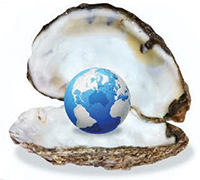
Simon Senaratna, a lawyer, CEO , and a pioneer in tourism,
Deshabandu Dr. T. Publis Silva , a chef who is now considered a national treasure,
Professor Suranga Silva , a university professor, and a leader in tourism,
Sohan Weerasinghe, a lawyer turned ever-green western musician.
Dr. Shanaka Kulathunga, a doctor turned award-winning portrait artist.
Features
The heart-friendly health minister

by Dr Gotabhya Ranasinghe
Senior Consultant Cardiologist
National Hospital Sri Lanka
When we sought a meeting with Hon Dr. Ramesh Pathirana, Minister of Health, he graciously cleared his busy schedule to accommodate us. Renowned for his attentive listening and deep understanding, Minister Pathirana is dedicated to advancing the health sector. His openness and transparency exemplify the qualities of an exemplary politician and minister.
Dr. Palitha Mahipala, the current Health Secretary, demonstrates both commendable enthusiasm and unwavering support. This combination of attributes makes him a highly compatible colleague for the esteemed Minister of Health.
Our discussion centered on a project that has been in the works for the past 30 years, one that no other minister had managed to advance.
Minister Pathirana, however, recognized the project’s significance and its potential to revolutionize care for heart patients.
The project involves the construction of a state-of-the-art facility at the premises of the National Hospital Colombo. The project’s location within the premises of the National Hospital underscores its importance and relevance to the healthcare infrastructure of the nation.
This facility will include a cardiology building and a tertiary care center, equipped with the latest technology to handle and treat all types of heart-related conditions and surgeries.
Securing funding was a major milestone for this initiative. Minister Pathirana successfully obtained approval for a $40 billion loan from the Asian Development Bank. With the funding in place, the foundation stone is scheduled to be laid in September this year, and construction will begin in January 2025.
This project guarantees a consistent and uninterrupted supply of stents and related medications for heart patients. As a result, patients will have timely access to essential medical supplies during their treatment and recovery. By securing these critical resources, the project aims to enhance patient outcomes, minimize treatment delays, and maintain the highest standards of cardiac care.
Upon its fruition, this monumental building will serve as a beacon of hope and healing, symbolizing the unwavering dedication to improving patient outcomes and fostering a healthier society.We anticipate a future marked by significant progress and positive outcomes in Sri Lanka’s cardiovascular treatment landscape within the foreseeable timeframe.
Features
A LOVING TRIBUTE TO JESUIT FR. ALOYSIUS PIERIS ON HIS 90th BIRTHDAY

by Fr. Emmanuel Fernando, OMI
Jesuit Fr. Aloysius Pieris (affectionately called Fr. Aloy) celebrated his 90th birthday on April 9, 2024 and I, as the editor of our Oblate Journal, THE MISSIONARY OBLATE had gone to press by that time. Immediately I decided to publish an article, appreciating the untiring selfless services he continues to offer for inter-Faith dialogue, the renewal of the Catholic Church, his concern for the poor and the suffering Sri Lankan masses and to me, the present writer.
It was in 1988, when I was appointed Director of the Oblate Scholastics at Ampitiya by the then Oblate Provincial Fr. Anselm Silva, that I came to know Fr. Aloy more closely. Knowing well his expertise in matters spiritual, theological, Indological and pastoral, and with the collaborative spirit of my companion-formators, our Oblate Scholastics were sent to Tulana, the Research and Encounter Centre, Kelaniya, of which he is the Founder-Director, for ‘exposure-programmes’ on matters spiritual, biblical, theological and pastoral. Some of these dimensions according to my view and that of my companion-formators, were not available at the National Seminary, Ampitiya.
Ever since that time, our Oblate formators/ accompaniers at the Oblate Scholasticate, Ampitiya , have continued to send our Oblate Scholastics to Tulana Centre for deepening their insights and convictions regarding matters needed to serve the people in today’s context. Fr. Aloy also had tried very enthusiastically with the Oblate team headed by Frs. Oswald Firth and Clement Waidyasekara to begin a Theologate, directed by the Religious Congregations in Sri Lanka, for the contextual formation/ accompaniment of their members. It should very well be a desired goal of the Leaders / Provincials of the Religious Congregations.
Besides being a formator/accompanier at the Oblate Scholasticate, I was entrusted also with the task of editing and publishing our Oblate journal, ‘The Missionary Oblate’. To maintain the quality of the journal I continue to depend on Fr. Aloy for his thought-provoking and stimulating articles on Biblical Spirituality, Biblical Theology and Ecclesiology. I am very grateful to him for his generous assistance. Of late, his writings on renewal of the Church, initiated by Pope St. John XX111 and continued by Pope Francis through the Synodal path, published in our Oblate journal, enable our readers to focus their attention also on the needed renewal in the Catholic Church in Sri Lanka. Fr. Aloy appreciated very much the Synodal path adopted by the Jesuit Pope Francis for the renewal of the Church, rooted very much on prayerful discernment. In my Religious and presbyteral life, Fr.Aloy continues to be my spiritual animator / guide and ongoing formator / acccompanier.
Fr. Aloysius Pieris, BA Hons (Lond), LPh (SHC, India), STL (PFT, Naples), PhD (SLU/VC), ThD (Tilburg), D.Ltt (KU), has been one of the eminent Asian theologians well recognized internationally and one who has lectured and held visiting chairs in many universities both in the West and in the East. Many members of Religious Congregations from Asian countries have benefited from his lectures and guidance in the East Asian Pastoral Institute (EAPI) in Manila, Philippines. He had been a Theologian consulted by the Federation of Asian Bishops’ Conferences for many years. During his professorship at the Gregorian University in Rome, he was called to be a member of a special group of advisers on other religions consulted by Pope Paul VI.
Fr. Aloy is the author of more than 30 books and well over 500 Research Papers. Some of his books and articles have been translated and published in several countries. Among those books, one can find the following: 1) The Genesis of an Asian Theology of Liberation (An Autobiographical Excursus on the Art of Theologising in Asia, 2) An Asian Theology of Liberation, 3) Providential Timeliness of Vatican 11 (a long-overdue halt to a scandalous millennium, 4) Give Vatican 11 a chance, 5) Leadership in the Church, 6) Relishing our faith in working for justice (Themes for study and discussion), 7) A Message meant mainly, not exclusively for Jesuits (Background information necessary for helping Francis renew the Church), 8) Lent in Lanka (Reflections and Resolutions, 9) Love meets wisdom (A Christian Experience of Buddhism, 10) Fire and Water 11) God’s Reign for God’s poor, 12) Our Unhiddden Agenda (How we Jesuits work, pray and form our men). He is also the Editor of two journals, Vagdevi, Journal of Religious Reflection and Dialogue, New Series.
Fr. Aloy has a BA in Pali and Sanskrit from the University of London and a Ph.D in Buddhist Philosophy from the University of Sri Lankan, Vidyodaya Campus. On Nov. 23, 2019, he was awarded the prestigious honorary Doctorate of Literature (D.Litt) by the Chancellor of the University of Kelaniya, the Most Venerable Welamitiyawe Dharmakirthi Sri Kusala Dhamma Thera.
Fr. Aloy continues to be a promoter of Gospel values and virtues. Justice as a constitutive dimension of love and social concern for the downtrodden masses are very much noted in his life and work. He had very much appreciated the commitment of the late Fr. Joseph (Joe) Fernando, the National Director of the Social and Economic Centre (SEDEC) for the poor.
In Sri Lanka, a few religious Congregations – the Good Shepherd Sisters, the Christian Brothers, the Marist Brothers and the Oblates – have invited him to animate their members especially during their Provincial Congresses, Chapters and International Conferences. The mainline Christian Churches also have sought his advice and followed his seminars. I, for one, regret very much, that the Sri Lankan authorities of the Catholic Church –today’s Hierarchy—- have not sought Fr.
Aloy’s expertise for the renewal of the Catholic Church in Sri Lanka and thus have not benefited from the immense store of wisdom and insight that he can offer to our local Church while the Sri Lankan bishops who governed the Catholic church in the immediate aftermath of the Second Vatican Council (Edmund Fernando OMI, Anthony de Saram, Leo Nanayakkara OSB, Frank Marcus Fernando, Paul Perera,) visited him and consulted him on many matters. Among the Tamil Bishops, Bishop Rayappu Joseph was keeping close contact with him and Bishop J. Deogupillai hosted him and his team visiting him after the horrible Black July massacre of Tamils.
Features
A fairy tale, success or debacle

Sri Lanka-Singapore Free Trade Agreement
By Gomi Senadhira
senadhiragomi@gmail.com
“You might tell fairy tales, but the progress of a country cannot be achieved through such narratives. A country cannot be developed by making false promises. The country moved backward because of the electoral promises made by political parties throughout time. We have witnessed that the ultimate result of this is the country becoming bankrupt. Unfortunately, many segments of the population have not come to realize this yet.” – President Ranil Wickremesinghe, 2024 Budget speech
Any Sri Lankan would agree with the above words of President Wickremesinghe on the false promises our politicians and officials make and the fairy tales they narrate which bankrupted this country. So, to understand this, let’s look at one such fairy tale with lots of false promises; Ranil Wickremesinghe’s greatest achievement in the area of international trade and investment promotion during the Yahapalana period, Sri Lanka-Singapore Free Trade Agreement (SLSFTA).
It is appropriate and timely to do it now as Finance Minister Wickremesinghe has just presented to parliament a bill on the National Policy on Economic Transformation which includes the establishment of an Office for International Trade and the Sri Lanka Institute of Economics and International Trade.
Was SLSFTA a “Cleverly negotiated Free Trade Agreement” as stated by the (former) Minister of Development Strategies and International Trade Malik Samarawickrama during the Parliamentary Debate on the SLSFTA in July 2018, or a colossal blunder covered up with lies, false promises, and fairy tales? After SLSFTA was signed there were a number of fairy tales published on this agreement by the Ministry of Development Strategies and International, Institute of Policy Studies, and others.
However, for this article, I would like to limit my comments to the speech by Minister Samarawickrama during the Parliamentary Debate, and the two most important areas in the agreement which were covered up with lies, fairy tales, and false promises, namely: revenue loss for Sri Lanka and Investment from Singapore. On the other important area, “Waste products dumping” I do not want to comment here as I have written extensively on the issue.
1. The revenue loss
During the Parliamentary Debate in July 2018, Minister Samarawickrama stated “…. let me reiterate that this FTA with Singapore has been very cleverly negotiated by us…. The liberalisation programme under this FTA has been carefully designed to have the least impact on domestic industry and revenue collection. We have included all revenue sensitive items in the negative list of items which will not be subject to removal of tariff. Therefore, 97.8% revenue from Customs duty is protected. Our tariff liberalisation will take place over a period of 12-15 years! In fact, the revenue earned through tariffs on goods imported from Singapore last year was Rs. 35 billion.
The revenue loss for over the next 15 years due to the FTA is only Rs. 733 million– which when annualised, on average, is just Rs. 51 million. That is just 0.14% per year! So anyone who claims the Singapore FTA causes revenue loss to the Government cannot do basic arithmetic! Mr. Speaker, in conclusion, I call on my fellow members of this House – don’t mislead the public with baseless criticism that is not grounded in facts. Don’t look at petty politics and use these issues for your own political survival.”
I was surprised to read the minister’s speech because an article published in January 2018 in “The Straits Times“, based on information released by the Singaporean Negotiators stated, “…. With the FTA, tariff savings for Singapore exports are estimated to hit $10 million annually“.
As the annual tariff savings (that is the revenue loss for Sri Lanka) calculated by the Singaporean Negotiators, Singaporean $ 10 million (Sri Lankan rupees 1,200 million in 2018) was way above the rupees’ 733 million revenue loss for 15 years estimated by the Sri Lankan negotiators, it was clear to any observer that one of the parties to the agreement had not done the basic arithmetic!
Six years later, according to a report published by “The Morning” newspaper, speaking at the Committee on Public Finance (COPF) on 7th May 2024, Mr Samarawickrama’s chief trade negotiator K.J. Weerasinghehad had admitted “…. that forecasted revenue loss for the Government of Sri Lanka through the Singapore FTA is Rs. 450 million in 2023 and Rs. 1.3 billion in 2024.”
If these numbers are correct, as tariff liberalisation under the SLSFTA has just started, we will pass Rs 2 billion very soon. Then, the question is how Sri Lanka’s trade negotiators made such a colossal blunder. Didn’t they do their basic arithmetic? If they didn’t know how to do basic arithmetic they should have at least done their basic readings. For example, the headline of the article published in The Straits Times in January 2018 was “Singapore, Sri Lanka sign FTA, annual savings of $10m expected”.
Anyway, as Sri Lanka’s chief negotiator reiterated at the COPF meeting that “…. since 99% of the tariffs in Singapore have zero rates of duty, Sri Lanka has agreed on 80% tariff liberalisation over a period of 15 years while expecting Singapore investments to address the imbalance in trade,” let’s turn towards investment.
Investment from Singapore
In July 2018, speaking during the Parliamentary Debate on the FTA this is what Minister Malik Samarawickrama stated on investment from Singapore, “Already, thanks to this FTA, in just the past two-and-a-half months since the agreement came into effect we have received a proposal from Singapore for investment amounting to $ 14.8 billion in an oil refinery for export of petroleum products. In addition, we have proposals for a steel manufacturing plant for exports ($ 1 billion investment), flour milling plant ($ 50 million), sugar refinery ($ 200 million). This adds up to more than $ 16.05 billion in the pipeline on these projects alone.
And all of these projects will create thousands of more jobs for our people. In principle approval has already been granted by the BOI and the investors are awaiting the release of land the environmental approvals to commence the project.
I request the Opposition and those with vested interests to change their narrow-minded thinking and join us to develop our country. We must always look at what is best for the whole community, not just the few who may oppose. We owe it to our people to courageously take decisions that will change their lives for the better.”
According to the media report I quoted earlier, speaking at the Committee on Public Finance (COPF) Chief Negotiator Weerasinghe has admitted that Sri Lanka was not happy with overall Singapore investments that have come in the past few years in return for the trade liberalisation under the Singapore-Sri Lanka Free Trade Agreement. He has added that between 2021 and 2023 the total investment from Singapore had been around $162 million!
What happened to those projects worth $16 billion negotiated, thanks to the SLSFTA, in just the two-and-a-half months after the agreement came into effect and approved by the BOI? I do not know about the steel manufacturing plant for exports ($ 1 billion investment), flour milling plant ($ 50 million) and sugar refinery ($ 200 million).
However, story of the multibillion-dollar investment in the Petroleum Refinery unfolded in a manner that would qualify it as the best fairy tale with false promises presented by our politicians and the officials, prior to 2019 elections.
Though many Sri Lankans got to know, through the media which repeatedly highlighted a plethora of issues surrounding the project and the questionable credentials of the Singaporean investor, the construction work on the Mirrijiwela Oil Refinery along with the cement factory began on the24th of March 2019 with a bang and Minister Ranil Wickremesinghe and his ministers along with the foreign and local dignitaries laid the foundation stones.
That was few months before the 2019 Presidential elections. Inaugurating the construction work Prime Minister Ranil Wickremesinghe said the projects will create thousands of job opportunities in the area and surrounding districts.
The oil refinery, which was to be built over 200 acres of land, with the capacity to refine 200,000 barrels of crude oil per day, was to generate US$7 billion of exports and create 1,500 direct and 3,000 indirect jobs. The construction of the refinery was to be completed in 44 months. Four years later, in August 2023 the Cabinet of Ministers approved the proposal presented by President Ranil Wickremesinghe to cancel the agreement with the investors of the refinery as the project has not been implemented! Can they explain to the country how much money was wasted to produce that fairy tale?
It is obvious that the President, ministers, and officials had made huge blunders and had deliberately misled the public and the parliament on the revenue loss and potential investment from SLSFTA with fairy tales and false promises.
As the president himself said, a country cannot be developed by making false promises or with fairy tales and these false promises and fairy tales had bankrupted the country. “Unfortunately, many segments of the population have not come to realize this yet”.
(The writer, a specialist and an activist on trade and development issues . )

